Sphinginae subfamily
Sphingini tribe:
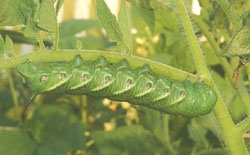 |
The caterpillars are called Tomato Hornworms and each has a black horn at the end of the abdomen.
Larvae feed on potato, tobacco, tomato, and other plants in the
nightshade family (Solanaceae).
|
 |
Sphinx chersis
WO, the Northern Ash Sphinx or Great Ash
Sphinx:
The larvae are pale bluish green. The head has a pair of yellow
lateral bands meeting at the apex. The oblique, lateral stripes are
pale and bordered anteriorly with a darker green.
Larval hosts are ash, lilac, privet, cherry, and quaking aspen. questionable, probably not
|
 |
Larvae hide in the day and feed primarily on cherry, plum, and apple
at night. Larvae have been found on Amelanchier nantuckensis
in Massachusetts and have been reared to pupation in Michigan on
Prunus serotina. Note purple oblique lines.
|
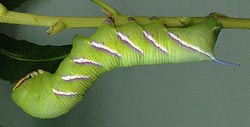 |
Sphinx perelegans
WO, the
Elegant Sphinx:
The basic body colour can be either glaucous or apple-green, without the earlier body tubercles. The oblique side stripes are white,
edged with purple.
The horn is sky blue. The spiracles are pale orange and the anal flap is edged with yellow.
|
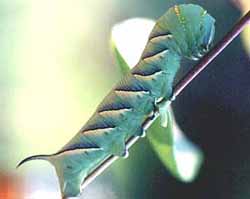 | Larvae feed on the common snowberry (Symphoricarpos albus)
and on coralberry (S. orbiculatus). Note the two golden
lines of slightly raised bumps, one just behind the head, the other
on the thorax.
|
Smerinthini Tribe:
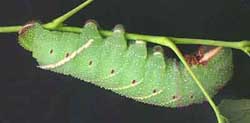 |
Pachysphinx modesta
WO,
the Modest Sphinx or Poplar Sphinx
Larvae feed on poplars and cottonwood.
The anal horn is greatly reduced in the final instar.
|
 |
Larvae feed on cottonwood and poplar (Populus) and willow
(Salix).
Larvae are very chunky with little to distinguish them
from Pachysphinx modesta.
|
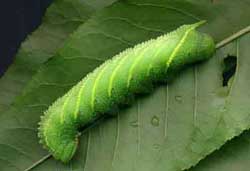 |
Larvae accept willows, birches, and cherries.
I have also found them in the wild on oak in eastern Canada.
Skin is quite granulous.
|
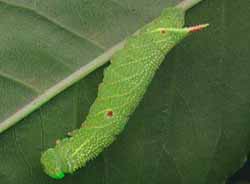 |
Wild cherry species are the favorites as larval foodplants, but eggs
will also be deposited on birches and other forest trees.
There are varying degrees in the amount of red markings along the sides.
|
 |
Smerinthus cerisyi
WO,
Cerisy's Sphinx;
Cerisyi larvae greatly resemble modesta larvae, both being pale
green, with granular skin, pale lateral diagonal lines, faint red
spiracular circles, and very pale longitudinal lines running from the
head to a more pronounced anal diagonal line.
Larvae have green heads bounded dorsally with a pale yellow
inverted "V".
|
Macroglossinae subfamily
Dilophonotini tribe:
 |
Larval host plants include Snowberry (Symphoricarpos),
honeysuckle (Lonicera), Coralberry, viburnums, high bush cranberry and hawthorn (Crataegus).
Horn is black with a slightly lighter base. This western species was formerly classified as
H. diffinis or H. senta. Those species west of the Continental Divide are now classified as
H. thetis.
|
Macroglossini tribe:
 |
Arctonotus lucidus
WO, the Pacific Green Sphinx or Bear Sphinx
Larvae feed on evening primrose (Oenothera dentata var. campestris) and
clarkias. David Wikle fed them on both Mexican evening primrose, Oenothera berlandieri and evening primrose, Oenothera biennis.
Earlier instars are green. Eye at dorsal posterior appears in fifth instar.
|
 |
Hyles gallii
WO, the Bedstraw Hawk Moth
or Gallium Sphinx
This species is not reported in Chippewa, but it has been recorded in
eastern Wisconsin counties. I suspect it is present.
Larvae come in black and in brown forms and often feed on
Epilobium (fireweed).
|
 |
Hyles lineata
USGS, the White-lined Sphinx
Larvae are highly varied and feed on a great diversity of plants
including willow weed (Epilobium), four o'clock (Mirabilis),
apple (Malus), evening primrose (Oenothera), elm
(Ulmus), grape (Vitis), tomato (Lycopersicon),
purslane (Portulaca), and Fuschia.
All larvae seem, however, to have the red/black swellings split by
dorso-lateral lines.
|
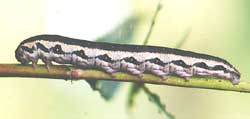 |
Larvae feed on elegant fairyfan (Clarkia unguiculata) in the evening primrose family (Onagraceae).
|
 |
Larvae feed on willow weed (Epilobium) and possibly thimbleberry (Rubus parviflorus).
|
|
|
